

13 SMART Goals Examples for Technical Writers
Technical writing is a critical skill that enables writers to communicate technical information clearly and concisely. Developing SMART goals can ensure that your writing projects are successful by providing a concrete framework.
To succeed as a technical writer, you must set effective goals and objectives to work towards. In this article, we’ll discuss some examples of SMART goals for technical writers to help them reach their targets.
Table of Contents
What is a SMART Goal?
The SMART ( Specific, Measurable, Attainable, Relevant, Time-based ) system will enable technical writers to establish effective goals for success.
Still trying to understand? Let’s dive deeper into each SMART letter:
When setting goals for your technical writing career, specificity is key. Rather than simply saying, “I want to be a successful technical writer ,” take the time to define what success means to you.
Want to become an expert in a particular field? Do you aspire to land top-tier clients or secure high-paying contracts? Once you’ve identified your specific goals, you’ll find it much easier to chart a course toward reaching them.
For technical writers to be successful, they must possess the ability to measure their progress to reach their ultimate objective. Following the SMART criterion will help you anticipate any obstacles that may come along and use them as invaluable learning experiences on your journey ahead.
Many of us dream big when it comes to goal setting . We often set our sights high and aim for the stars. While ambition is an admirable trait, recognize that not all goals are created equal. In truth, setting unrealistic goals can hinder our progress and discourage us.
That’s why you must strive to be practical. Take a step back and consider what’s achievable within your current circumstances. It may mean adjusting your expectations or breaking larger goals into more attainable milestones.
Crafting meaningful goals that reflect your core beliefs will drive you to achieve the desired outcome. Even during the most trying times, your steadfast core values will be a constant source of guidance and support.
A reliable timeline ensures that your progress remains steady and you never lose sight of your achievements. Success is not a one-night wonder but an ongoing effort of dedication and perseverance. Time will be needed to help your journey to greatness blossom into fruition.
Here are 13 examples of SMART goals for technical writers:
1. Improve Writing Speed
“To increase my efficiency and productivity, I’ll double my average words per minute by the end of 7 months. I’ll achieve this using tech-based tools, such as automated copyediting software, to help me write faster and more accurately.”
Specific: This goal outlines what you need to do (use tech-based tools) and how much faster you’ll become (doubling your words per minute).
Measurable: You could measure your words-per-minute rate before and after.
Attainable: This SMART goal is achievable using the right tools and techniques.
Relevant: The statement applies to improving your efficiency and productivity as a technical writer.
Time-based: Success will be reached in the following 7 months.
2. Expand Technical Knowledge
“I will acquire a deeper understanding of complex technical topics by attending at least two seminars related to technical writing within 6 months. I hope this will help me keep up with our clients’ ever-evolving content development needs.”
Specific: The goal is concise and clear, detailing precisely the objective and how it will be achieved.
Measurable: By attending seminars, you can measure your technical knowledge.
Attainable: This goal can be accomplished by attending seminars related to technical writing.
Relevant: This is relevant to technical writing because it ensures you have the knowledge and skills to meet our clients’ content development needs.
Time-based: There is a 6-month end date for meeting this particular goal.
3. Boost Your Productivity
“I’ll increase my productivity by 20% in the next four months by implementing a few tactics to help me meet deadlines more efficiently. I’ll focus on streamlining workflows, maintaining a consistent schedule, and staying organized.”
Specific: This SMART goal explicitly wants to increase productivity by 20% in four months.
Measurable: Track your current productivity levels and measure any improvements after implementing the tactics.
Attainable: Increasing productivity by 20% in four months is realistic if you plan correctly and remain organized.
Relevant: This is relevant to those struggling to stay on top of deadlines or who want to increase their productivity.
Time-based: Goal completion is anticipated after four months.
4. Manage Time Effectively
“My aim is to spend no more than two hours per day on emails and other non-essential tasks by the end of two months. I will use time management tools to ensure I spend my time on productive tasks that help meet the organization’s overall goals.”
Specific: You have precise actions available—use time management tools and limit yourself to two hours per day on emails.
Measurable: Ensure you spend at most two hours on emails daily.
Attainable: Given the proper planning and strategies, this is an achievable goal.
Relevant: This goal relates to your primary objective of managing your time effectively.
Time-based: You should expect goal attainment within two months.
5. Enhance Research Skills
“Within two months, I’ll improve my research capabilities by attending a course on the latest techniques and strategies used in gathering data. That will help me to provide accurate, up-to-date information for our publications and other documents.”
Specific: This statement focuses on the advancement of research skills.
Measurable: Attendance in a course is the objective measure for improvement.
Attainable: Attending a course is the quickest and most effective way to gain knowledge.
Relevant: The research skills gained will be applicable in gathering data for documents.
Time-based: There is a two-month timeline to complete this goal.
6. Optimize Workflow Processes
“I want to identify and implement two methods to improve my technical writing workflow processes after three months. I will measure the resulting improvement in turnaround time and document best practices to ensure long-term efficiency.”
Specific: The individual wants to identify and implement two methods to improve their technical writing workflow processes.
Measurable: They will measure the improvement in turnaround time.
Attainable: This is feasible because the person has clearly outlined a specific action plan to improve their workflow processes.
Relevant: The goal is appropriate because it focuses on optimizing workflow processes, which will improve the quality of technical writing.
Time-based: The statement is time-bound because it has an end date of three months.
7. Strengthen Collaboration Skills
“For the 5 months ahead, I will develop a strategy to improve collaboration skills within our team and with other departments. That could include attending conferences, taking classes, and using collaboration software.”

Specific: This goal is evident because you plan to strengthen collaboration skills .
Measurable: You can track time and resources spent on each step of the plan.
Attainable: The individual has identified a reasonable timeline and activities to develop collaboration skills.
Relevant: Collaboration skills are precious in the workplace and can improve team performance.
Time-based: You should accomplish this goal within 5 whole months.
8. Advance Editing Abilities
“I want to increase my editing abilities by completing a course on copyediting within three months. The course will allow me to become more efficient and accurate when editing documents for my team’s projects.”
Specific: The statement outlines the objective , what steps need to be taken, and a timeline.
Measurable: Track your progress by keeping work samples and assessments from the course.
Attainable: With proper dedication, completing the copyediting course within three months is possible.
Relevant: This is relevant for technical writers because it will help them become better editors.
Time-based: You have three months to complete the course.
9. Grow Networking Opportunities
“I’ll actively reach out to industry professionals and groups to attend a minimum of two networking events each month. Over the course of 8 months, I hope to have a network of at least 10 contacts in the technical writing industry.”
Specific: The goal specifies what needs to be done and how long it should take.
Measurable: You could count the number of contacts made.
Attainable: This is possible if you dedicate time every month to meeting industry professionals.
Relevant: Networking can help you learn more about the technical writing industry, find job opportunities, and gain valuable contacts.
Time-based: Eight months are required to accomplish success.
10. Improve Quality of Writing
“I will strive to improve the quality of my writing within four months by taking classes and implementing feedback from my colleagues. I plan to be more aware of grammar and punctuation rules and ensure my writing is free from typos.”
Specific: This goal is clear because it focuses on improving the quality of writing by taking classes and incorporating feedback.
Measurable: Using classes and feedback, the writer can measure their writing quality against previous pieces.
Attainable: This SMART goal is achievable with the help of classes and colleagues.
Relevant: Improving the quality of writing is essential for any technical writer.
Time-based: You will meet this particular goal within four months.
11. Design Easy-to-Read Layouts
“I will design layouts for all technical documents to be easily read and navigated within 6 months. I’ll make sure that the information is presented logically, with headings, summaries, and other features that help readers quickly find the information they need.”
Specific: The goal outlines what you must do (design layouts) and how long it should take (6 months).
Measurable: You can measure the number of layouts you’ve created.
Attainable: Designing layouts is absolutely doable within the given time frame.
Relevant: This goal helps create readable and navigable technical documents.
Time-based: Goal attainment is expected within 6 months.
12. Create User Guides
“I’ll create user guides for all technology products I am responsible for by the end of 5 months. These guides must be written clearly and concisely and include helpful tutorials.”
Specific: The statement is explicit as it outlines the task of creating user guides.
Measurable: The technical writer can measure the completion of guides over time.
Attainable: Creating user guides is possible, given the deadline and resources in place.
Relevant: Designing user guides directly relates to the technical writer’s role.
Time-based: This goal must be achieved over the 5 months ahead.
13. Reduce Turnaround Time
“I will create an efficient process to reduce the turnaround time for technical writing projects by 25% within 9 months. Projects should be completed quickly while still maintaining a high degree of accuracy and quality.”
Specific: The goal is well-defined. The individual knows they need to reduce turnaround time for technical writing projects.
Measurable: The writer will reduce the turnaround time by 25% within 9 months.
Attainable: This is absolutely doable if given the necessary resources and time.
Relevant: The goal is appropriate for the individual’s need to reduce turnaround time.
Time-based: Optimal success will be met by the end of 9 months.
Final Thoughts
SMART goals are an excellent way to set and reach your professional objectives—and get the recognition you deserve. By fulfilling the 5 SMART criteria, you can design an action plan to bring your ideas to life.
Don’t be afraid to be creative and push yourself as far as possible: great accomplishments come from taking risks. So go out there and make your mark as a technical writer with SMART goals.
This post may feature products and services that we think you’ll find useful. Please read our disclosure for more information.
Technical Writer Professional Goals
Getting started as a technical writer.
- What is a Technical Writer
- How to Become a Technical Writer
- Certifications
- Tools & Software
- LinkedIn Guide
- Interview Questions
- Similar Job Titles
- Work-Life Balance
- Professional Goals
- Technical Writer Resume Examples
- Technical Writer Cover Letter Examples
Track Your Goals with Teal
Log your goals and career aspirations on an ongoing basis to keep career groth front of mind with Teal.
Why Every Technical Writer Should Have Goals
Different types of career goals for technical writers, proficiency and knowledge goals, process and efficiency goals, collaboration and networking goals, visibility and influence goals, leadership and management goals, what makes a good career goal for a technical writer , career goal criteria for technical writers, mastery of technical skills.
- Adopt Cutting-Edge Authoring Tools
- Enhance Documentation Design Skills
- Stay Current with Industry Trends
Audience-Centric Approach
- Identify Key User Personas
- Gather Regular User Feedback
- Adapt Content for User Clarity
Strategic Collaboration
- Master Product Knowledge
- Enhance Team Communication
- Develop Documentation Strategy
Industry Expertise
- Master Technical Jargon
- Engage with Industry Trends
- Develop Niche Expertise
Log Your Wins Every Week with Teal

12 Professional Goal Examples for Technical Writers
Master technical communication tools, expand knowledge in a technical domain, develop project management skills, strengthen collaboration with subject matter experts, enhance user experience (ux) writing skills, adopt content strategy best practices, pursue a professional technical writing certification, contribute to open source documentation projects, lead documentation process improvements, mentor junior technical writers, write and publish technical articles or a blog, learn a programming language, career goals for technical writers at difference levels, setting career goals as an entry-level technical writer, setting career goals as a mid-level technical writer, setting career goals as a senior-level technical writer, leverage feedback to refine your professional goals, utilizing constructive criticism to sharpen writing skills, incorporating user feedback to enhance documentation relevance, leveraging performance reviews for strategic career development, goal faqs for technical writers, how frequently should technical writers revisit and adjust their professional goals, can professional goals for technical writers include soft skill development, how do technical writers balance long-term career goals with immediate project deadlines, how can technical writers ensure their goals align with their company's vision and objectives.
What is a Technical Writer?

More Professional Goals for Related Roles
Crafting compelling narratives, engaging audiences with powerful words and ideas
Crafting compelling narratives to drive brand engagement and consumer action
Shaping narratives, refining content to captivate audiences and uphold brand voice
Shaping compelling narratives, driving engagement through strategic content creation
Shaping brand narratives, driving engagement through compelling digital content
Shaping compelling narratives, refining content to engage readers and boost visibility
Are you sure you want to log out of Unmudl?
What is the goal of technical writing.
Technical writing is a type of writing which focuses on a specific topic that requires direction, instruction, or explanation. This writing style serves a specific purpose and thus differs greatly from other types of writing, such as creative writing, academic writing, or business writing.
Design documentation, user guides, reference and installation manuals, help desk sheets, tutorials, online documentation, and similar technical content are all examples of technical writing.
As a result, technical writing is essential in a wide range of businesses and industries. Without it, complex topics and procedures would be difficult – if not impossible – to comprehend and carry out by common people.

To recognize the significance of technical writing in your own business or industry, you must first understand what technical writing is, as well as its unique characteristics, different types, basic principles, and more.
In this comprehensive guide to learning everything there is to know about the subject, we ask the question: what is technical writing and what are its goals? Going through our guide you'll be an expert on the subject in no time.
Looking for courses on technical writing?
Unmudl has a proven course that can help you polish your skills!

What is the goal of technical writing?
Technical writing is a multifaceted skill. It can be used in a variety of ways. Many industries rely on Technical Writers to market their products and services. There are also different types and applications of Technical Writing in various fields of operation.
As we discussed earlier, every type of writing serves a purpose. Some forms of writing are designed to tell a story, while others are designed to express opinions. Technical writing is not intended to serve either of these functions.
The primary goal of technical writing is to convey complex information to readers in a way that they can understand and apply, even if they have no prior knowledge of the subject.
Technical writing explains how to use a specific object or how to complete a task or project. It is intended for readers seeking information on a specific topic, such as how to use a smartphone, or to provide detailed specifications on how to write this blog effectively.
Technical writing must be clear, concise, and simple for the target audience to follow, understand, and act on. These are essential elements of effective technical writing.
What is your role as a technical writer?
A technical writer's role is determined by their area of expertise and whether they work for a company or as an independent freelancer. Technical writers essentially act as a liaison between a company's technical staff and the end user.
They usually have to interact with multiple teams in order to understand the project well enough to write about it. This necessitates that technical writers become accomplished communicators.
In a way, they work as translators, ensuring that difficult technical information is accessible to the intended end user in an easily understandable form. It is frequently their responsibility to bring together multiple stakeholders on a project.
Other than writing, they spend a lot of time researching, preparing, and reviewing their work.
What helps to distinguish technical writing from other types of writing?
The tone and purpose of technical writing are distinct. It differs from other types of writing such as journalism, creative writing, academic writing, and business writing in tone and purpose.
Technical writing is frequently compared to and confused with business writing. This is due to the fact that it covers many of the same topics. While the two have some similarities, business writing is a broader category. Technical writing is a subset of business writing, or rather a specific type of business writing.
The goal of both business and technical writing is to be easily understood. Technical writing, however, is solely concerned with conveying information, whereas business writing can vary in style and tone.
Business writing, for example, can be persuasive, such as when attempting to sway someone toward your point of view. The goal of technical writing is always to be objective.
Technical writers do not attempt to persuade you to buy a specific laptop, for example. Instead, they focus on teaching you how to use one.
You may also want to read this blog that focuses on explaining the difference between technical writing and business writing.
What are the characteristics of technical writing?
If you are confused don’t worry, this section will highlight key characteristics of a technical written document so you can clearly identify it when you see one.
Technical writing has some distinguishing features that set it apart from all other types of writing and they are:
1. Problem-solving
Because the primary goal of technical writing is to solve problems, each document is written with this goal in mind. These texts are used by readers to learn how to complete specific tasks or to obtain technical information.
As a result, they are organized in such a way that they can be easily referred to when problems arise. For example, a how-to guide for troubleshooting problems with your printer.
Technical writing terminology is always very specific in order to precisely describe objects and processes.
3. Clearly written
Technical writing conveys information in a clear and concise manner, with little room for interpretation. As a result, it employs concise and unambiguous language.
4.Well structured
This writing style must have a clear structure that allows readers to easily follow along. This is due to the fact that readers rely on technical documents for step-by-step instructions.
5. Simple to understand
Effective technical writers avoid using complicated words, jargon, and slang that readers may not understand and instead choose to write in a simple, understandable tone.
6. Straightforward
It conveys information in a straightforward and to-the-point manner, without the use of creative writing techniques.
7. Denotative
This simply means that the literal definition of words is central to technical writing. It helps to avoid misunderstandings caused by the many different connotations—or suggestions—of words.
8. Elaborate
Technical writing is extremely detailed and informative, with no room for interpretation. A textbook is an excellent example of technical writing because textbooks often provide the most complete and factual overview of a topic.
9. Skimmability
Technical documents are written with 'Skimmability' in mind, so audiences can simply scan the entire text to obtain the information they require. Technical writers include descriptive headings as well as a detailed table of contents and/or index.
.webp)
What are some examples of technical writing?
Depending on the kind of documentation being written, there are different types of technical writing that can take place. We have put together a list and a short explanation of each important example. For an exhaustive list of all types of technical documents you can visit TechWhirl :
1. End-user instructions
When you purchase software, install a computer component, or purchase a digital device or consumer appliance, it comes with an instruction manual that explains how to use it.
These are known as end-user instructions, but they also include documents such as troubleshooting guides, assembly instructions, "dos and don'ts" lists, warranty details, and legal disclaimers.
The writers must analyze this highly technical information and convey it in a user-friendly language that a wide audience can understand.
Because this type of technical writing is intended for a specific audience, the writer must be aware of the reader's level of expertise as well as have extensive knowledge of the subject matter.
Examples include the user manual for your home theater system or the assembly instructions for a modular cabinet.
2. Technical papers
In addition to instructions and advice, many products provide information on the product's origin, development, or structural or operational modifications.
Technical writers organize and edit information to ensure clarity and accuracy in these documents.
3. Corporate reports and feasibility studies
A writer conducts extensive research for feasibility studies and corporate reports, such as a company's financial reports. This information must then be presented in such a way that it is easily understood by every level of employee, executive, or shareholder.
As a result, visual aids such as graphs or charts are frequently included within these reports and studies — particularly when discussing finance, timelines, and social or business practicality.
4. Case studies
Case studies are in-depth written analyses of real-world events. They may focus on individuals, groups, organizations, medical studies, business decisions, or the long-term study of a specific organization or individual subject.
They seek patterns in data about the subject, which they then use to make assumptions and detect trends. Case studies are common in scientific publications, but they can also be found in business and industry.
5. Research findings
Documents detailing relevant laboratory findings or other types of studies like surveys are frequently included in medical, pharmaceutical, and political research reports and documents.
Because this type of technical writing typically includes information on medication combinations, side effects, policy making, and other critical issues that directly impact human life or impact key decision making, extreme care must be taken.
6. Procedures and policies
To manage their organization, businesses of all sizes require guidelines outlining their policies and procedures.
A good example is an organization’s employee handbook which helps protect the company from lawsuits from employees who claim they were unaware of certain rules and regulations.
7. White papers
White papers are documents created by a company for an external audience to assist them in making decisions and solving relevant problems.
They are used in a variety of industries and businesses to discuss a problem and recommend a specific solution, product, technology, or procedure. For example, I recently read an excellent white paper on renewable energy sources, their application, and their benefits.
8. Proposals
Proposals are written with the intention of informing an individual or a group to take effective action. A proposal is commonly required when applying for grants, undertaking projects, or purchasing products.
Proposals are also required when considering improvements to an organization, product, process, or service.
Because a proposal must be extremely persuasive, it must be written with the intended audience in mind. The writer must also identify the situation and outline the recommended course of action while still being completely objective.
9. Business strategies and plans
Financial institutions require a detailed business plan before granting loans to new or established businesses.
These documents necessitate extensive technical research and comprehension of a company's finances and operations, including spending forecasts, potential losses, and profit margins, as well as competitive analysis, marketing practices, and detailed background information on the owner's professional history and financial health.
10. Literature reviews
A literature review can be used separately or as part of a larger report. It's a type of technical writing that summarizes what's known about a particular subject.
Literature reviews summarize and explain prior research and discoveries on a topic, highlighting research milestones, contradictory results, and what more research is needed to advance knowledge on the issue.
.webp)
Important Unmudl tips for Technical Writing
Following these key tips can lead to excellent professional-level technical writing, regardless of the type of technical documentation being produced:
1. Understand your target audience
An expert in that field will understand certain abbreviations, acronyms, and slang that are directly applicable to the topic.
But because someone with less experience or limited knowledge of that industry will not understand the information as well, every detail must be simplified, clarified, and laid out for them.
2. Use a neutral tone
Write in the third person, as if you were a teacher instructing a student. In technical writing, personal opinions should be avoided.
To ensure that the reader understands the process or instructions, the writing should be direct, to the point, and as simple as possible — whether it's a simple list of tasks to accomplish a goal or a detailed explanation of an idea or abstract concept.
3. Conduct extensive research
Collect information from various sources, analyze the data so that it is thoroughly understood, and then present the information in an easy-to-understand format to instruct those who read it.
The more inexperienced your audience, the more information you must gather and analyze.
4. Be thorough
Be detailed in your description and include enough information to convey your points; however, consider word efficiency to avoid boring your reader with unnecessary material.
A technical writer should be able to simplify a difficult process and explain a complicated piece of information professionally and effectively if they follow our tips.
How to become a technical writer
Did you know that technical writers can earn up to $74,650 per year, according to the US Bureau of Labor Statistics ? Besides that, the career has some of the most promising job prospects for the coming decade with 12 percent growth between 2020 and 2030, faster than the average for all occupations.
A bachelor's degree in English, communications, or journalism is highly recommended for a technical writer. Some technical writers may be expected to have a specific technical background or work experience with technology companies.
Since we frequently get asked if technical writing is hard in college, we have a dedicated article discussing the subject.
Coming back to Technical writers, they may also be required to have knowledge of specific computer languages as well as the ability to use a variety of word-processing, layout, and graphics tools for both print and online documents.
We highly recommend either of these two courses that can earn you a certificate in technical writing, greatly boosting your employment and promotion prospects in the industry.
- Technical Writing course from Pima Community College
- Technical Writing course from Tombolo Institute at Bellevue College
You may also want to read our special guide on how to get into technical writing with a certificate .
Final thoughts
Technical writing has existed since written languages were invented, but its popularity is growing fast — especially in our rapidly advancing era of telecommunications. The practice shows no signs of slowing down and will remain an important part of our lives for decades to come.
Technical writing, as we discussed, simplifies the complex. It enables certain ideas, theories, practices, or procedures to be communicated in an understandable or conceivable manner.
As a result, it is extremely relevant to any business or industry that uses technical documentation, end-user instructions, technical reports, feasibility studies and corporate reports, research results, policies and procedures, business plans, white papers, case studies, literature reviews, proposals, and other similar tools.
In this article, we looked at the goals of technical writing and its features and characteristics. We hope this information has been useful to you in your career development.
Frequently Asked Questions
What are the main goals of technical writing, what is the meaning of technical writing, what is the importance of technical writing in the workplace, contributor(s).

The Unmudl Skills Team is a team of experts with decades of experience in helping learners acquire the skills needed to secure meaningful employment in the workforce.
More Articles

Excel Data Analyst Ultimate Guide

Best Project Management Books for Beginners

Are Excel Courses Worth It?
Technical Writing Process: Step-by-step Guide

In this article, we’re bringing you a technical writing process that will help you create valuable, focused, and well-researched documentation for every feature of your product.

The process of writing technical documentation is by no means an easy one.
In addition to having excellent writing skills, you also need to have a working knowledge of the product you’re writing about.
In addition, inaccurate or badly written documentation can seriously endanger the value of the product you’re offering, as well as harm the company’s reputation.
Luckily, this process can be mastered.
In this article, we’re bringing you a step-by-step guide that’s sure to help you create valuable, focused, and well-researched documentation for every feature of your product.
And we’re kicking things off with the most important person in the technical writing process: the intended reader.
Define Your Reader
Knowing your audience is important for any type of writing. However, technical writers should be aware that defining who their readers are is essential to their work.
If you don’t know who you’re writing for, your document may become totally useless.
Consider this technical document about APIs:

While a developer might be able to understand the information presented here quite easily, someone with a different background won’t be able to make heads or tails of it.
Generally speaking, your readers can be sorted into the following categories :
- Management: The people funding your project
- Experts: The people developing your project
- End-users: The people who will be using the end product (e.g. customers or company employees)
The members of these categories will have different goals for reading your documents and they’ll also have different levels of technical knowledge, as we saw in the example above, meaning you need to adapt your writing to each audience category.
A great method that will help you define your readers and focus on the right audience is to develop reader personas.
In a nutshell, personas are fictitious readers of your writing.
They put a human face on your intended audience and help you keep the reader’s perspective in your mind while you’re structuring and writing your article.
Let’s look at a practical example.
Tails is a portable operating system built to protect users against surveillance and censorship.
The Tails team built the network using multiple personas, so they’d always know how to approach their audience’s needs and how to help them use their system by writing technical documents their audience will easily understand.
Here’s their primary persona:
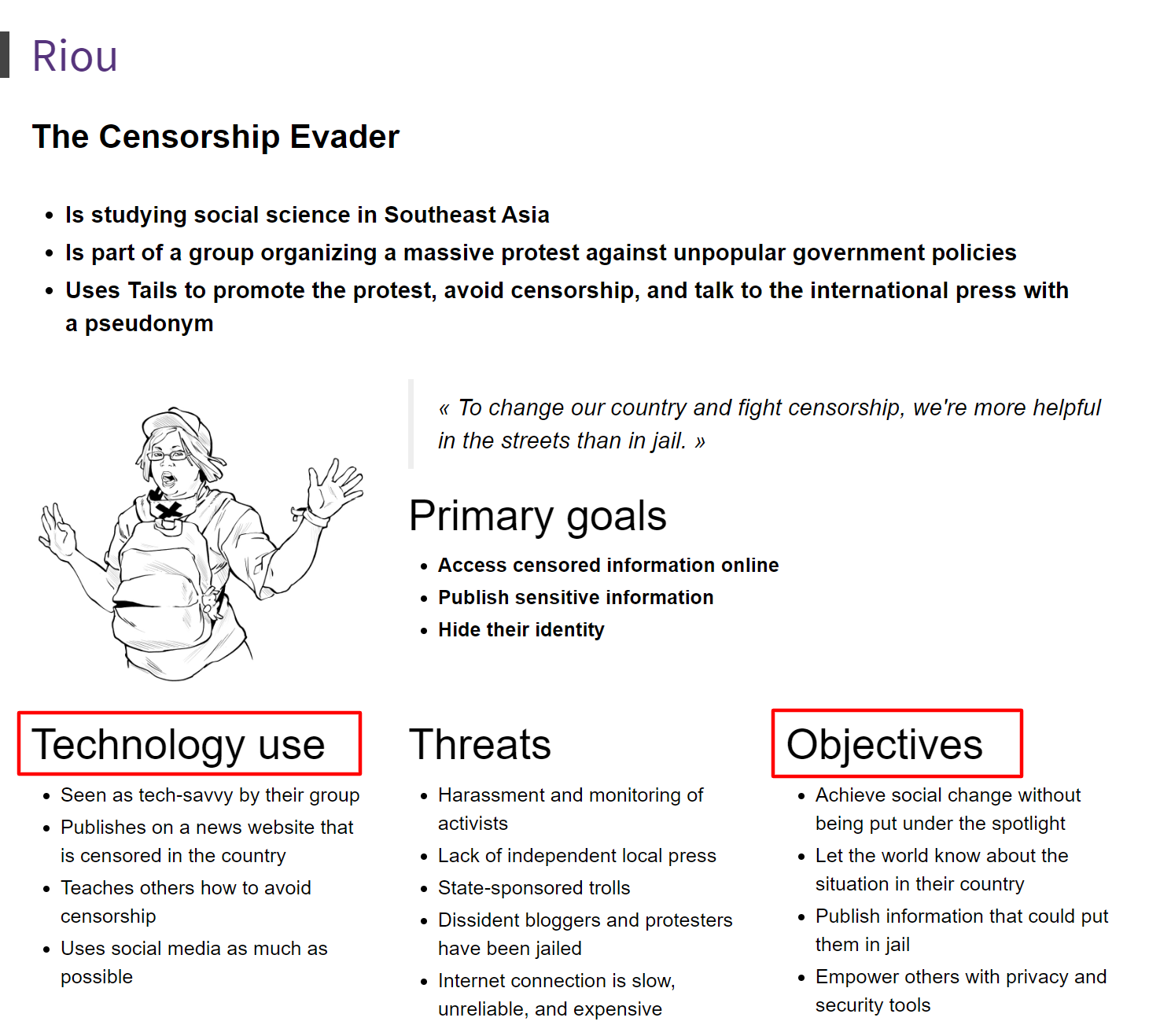
As you can see, there are sections dedicated to the types of technology the audience might use as well as their objectives, which helps the technical writer create documentation that caters to their needs and presents technical information using concepts and terminology that the reader already knows.
This is what the end-product, the documentation intended for Tails’ users looks like. Every article was developed with the above persona in mind.

The key takeaway here is that different users of your documentation will need a different approach.
So find out who your readers are, define them in as much detail as possible, and always write with them in mind.

Define Some Clear Goals for Your Document
Speaking of document goals, they’re another essential aspect you should define before you write a single word of your technical document.
Before we explain further, it might be a good idea to remind ourselves that the main goal of technical writing is simplifying the complex .
So, whatever type of document you’re writing, try to keep this primary goal in mind.
After that, think of what else you’re trying to achieve with your writing.
Are you trying to inform your reader about the benefits and purposes of your product or do you want to help them install and use it?
The answer to this question should guide your writing and help you stay on point, making your job much easier.
Let’s look at two examples from ChartHop to see how different goals inform differently written documents.
First up, here’s an article from ChartHop’s knowledge base that explains different product package options.

As you can see, the article lays out the available packages and explains the capabilities of each one.
This article informs and makes suggestions for customers who are trying to decide which option suits them best.
On the other hand, this article provides specific instructions on how to use the platform.
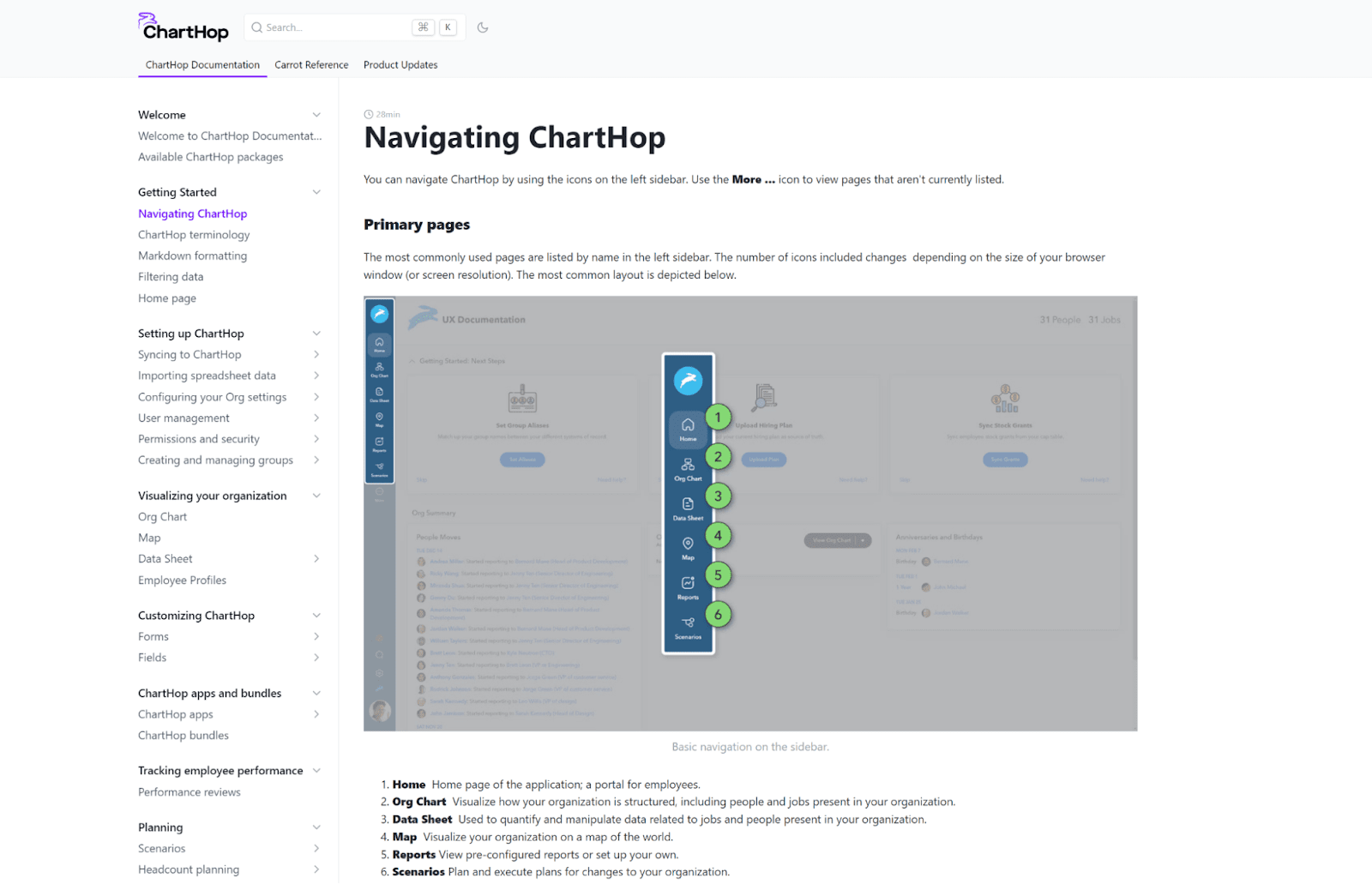
The article includes a screenshot of the interface and clear instructions on how different features of the software are used.
The reader whose goal is to learn to use the product will definitely find value in this document.
Now imagine if these articles were written without a goal.
For example, the article about navigation might have been written to reflect how unique the navigational features of the app are or how much time the developers put into creating them.
That wouldn’t be a very useful article for the reader using the product, would it?
This is the awesome difference that writing with a clear goal in mind can provide for your work.
When writing with clearly defined goals, you’re ensuring that you’re creating the right content for the right users.
Properly Research the Subject
With your readers and goals clearly defined, it’s time to dive into research about the topic you’re covering.
This is another unskippable step because you don’t want to provide your readers with inaccurate information.
Providing inaccurate technical documentation can damage your company’s reputation.
The end-users who rely on it will encounter problems using your product, meaning their user experience won’t be optimal.
Ultimately, this may cause them to churn from your service and voice their dissatisfaction to others, costing your company revenue and subscribers.
Here’s a real-life example of how that can happen.

That’s why it’s extremely important to write only what you know and deliver instructions you are certain of. And the only way to do that is to conduct thorough research before you start writing.
You can start your research by exploring the product and features you’re writing about. Get comfortable using it and learn its ins and outs.
Once you know how to use something, it's much easier to explain the feature to others.
Next, identify the subject matter experts (SMEs). These might be the people who developed the feature you’re writing about.
After all, who better to explain how a feature of a product works than the experts who designed it?
Prepare your questions and set up the meetings with the SMEs to fill in your knowledge gaps.
If you want to create a good workflow for your SME meetings, try using a meeting app, like Hypercontext to easily schedule meetings and set up agendas so that everyone comes to the meeting prepared.

Last but not least, do some secondary reading on the subject. Use the power of the internet and Google to find recent expert articles about the topics you’re writing about.
As you know, there’s a lot of misinformation out there, so check and double-check your sources for trustworthiness.
As a technical writer dedicated to a single project, you’ll probably often revisit quality articles and studies, so building a library of articles dedicated to your subject might be a good idea.
You can try using bookmark tools such as Raindrop for that purpose.

With first-hand experience using the product you’re writing about, some help from the experts in the field, and a good amount of reading, you got all your research corners covered and can start writing with confidence.
Create an Outline First
Creating an outline is a great way to ensure that your article is easy to navigate and structured in a way that helps readers find the information they need quickly and effortlessly.
You don’t want to present your audience with a boring wall of text, so make sure your outline is logical and helpful to the user.
You can start by coming up with a good, actionable title for your article. Make it clear and to the point so that the reader immediately knows they’ve found what they were looking for.
Here’s a great example:

Next, break up the subject into several subsections. These can be used as the headings of your article and can form your table of contents.

The majority of the body of the article will be found under these headings. They represent the topics covered by the article.
So, what else do you need?
Well, no article is complete without an introduction and a conclusion. Your introduction will lead the reader into the article and a good conclusion usually sums up the main points.
It’s also a good practice to preface your article with a list of prerequisites the reader should have to understand and properly use the knowledge you’re transferring.
Here’s a list of prerequisites from the same article:

And Voilà! Your outline is completed and it’s now much easier to begin writing your draft as the outline will serve as a roadmap for your work.
One final note. As you’ll be writing many articles on the same subject, it’s probably a good idea to use similar outlines for all of your documents.
This will not only ensure consistency of style, but will also save you a lot of time as you won’t be creating your outlines from scratch.
That’s why the best technical writers out there make good use of templates for each type of technical document they’re working on.
A good template will have the main headings already built in, meaning you can dive into writing right away.
Your technical documentation will (hopefully) always have a lot of knowledge to pass on.
A good outline guarantees that knowledge will be efficiently organized for the reader’s effortless use and should make your job a lot easier.
Write Your Draft
Let’s review. You have an intended reader and a clear goal in mind. You’ve done tons of research and have your notes on hand.
Your outline is finished and ready to guide you through the writing process.
At this point, the article you’re going to write should be bursting out of your mind half-finished.
As you’re sitting down to write your draft, remember our most important rule: technical writing is simplifying the complex .
To write a quality technical document, remember to keep things simple and to the point.
Use basic words as much as possible, this isn’t a vocabulary test.
Also, keep your sentences and paragraphs short, you don’t want your reader to get lost in a maze of arguments and instructions.
Here’s how that might look.
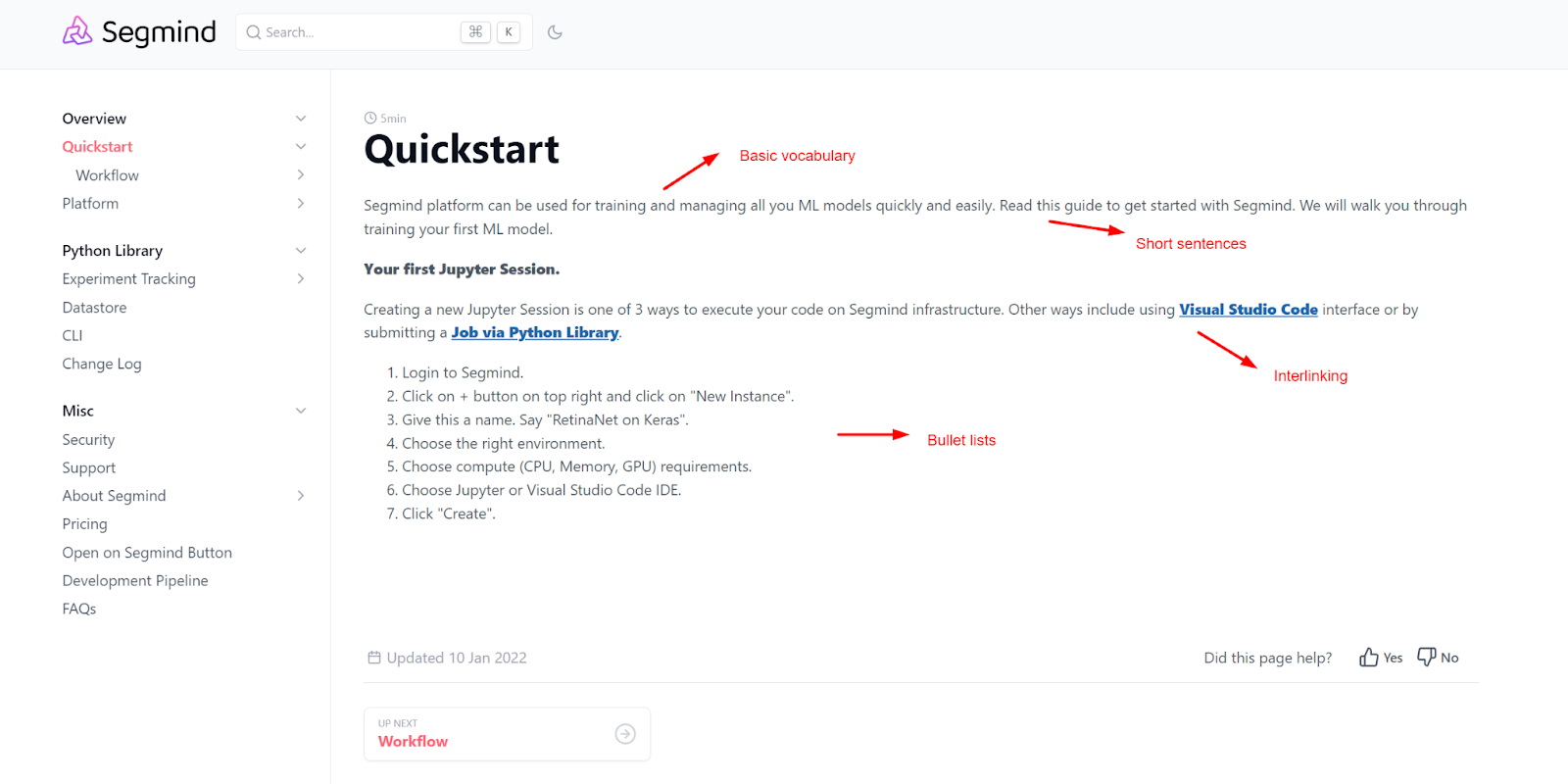
To prevent yourself from over-explaining and making your document too long, use interlinking to enable your readers to jump between articles and find out everything they need to know.
One more useful practice you can see in the example above is the use of bullet lists. These provide a graphic element to your article, making it easier to digest.
Speaking of graphic elements, you should also use visuals to illustrate your explanations.

Remember that humans are visual creatures and they’ll often understand complicated concepts more easily if they are presented in visual terms, like in the example above.
But it doesn't end there. If you’re using quality documentation software, like our own product, Archbee , there’s practically no end to the resources you can include in your documentation.
For example, you can show off code examples that users can easily copy.
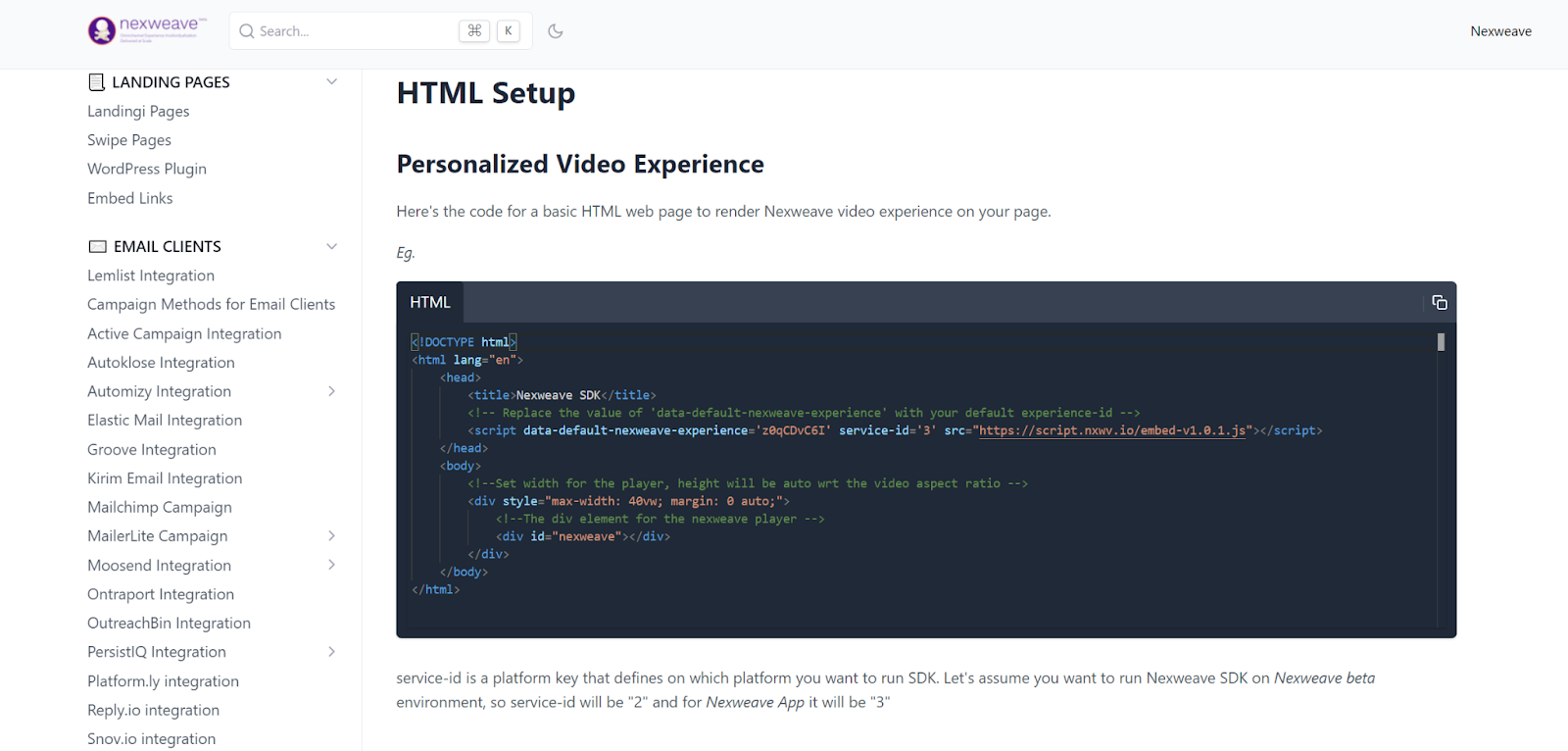
That’s because Archbee has a multi-code editor meaning writers can easily add code blocks to their documents for the users to access right away.
By the way, all of the examples provided in this section were taken from knowledge bases built with Archbee.
So far, we’ve helped more than 16,000 users create quality technical documentation, so check out some more examples here .
As you can see, with good preparation and quality tools, drafting a quality technical document doesn’t have to be an ordeal.
Use the resources available to you and write faster and better than ever.
Submit Your Document for Review
To reiterate a very important point, inaccurate technical documentation can be a very dangerous thing, both for your company and the end-users.
That’s why it’s paramount that your article passes multiple rounds of review before it’s published.
The more eyes you get on your work, the more accurate and polished the end result will be. But generally speaking, four review rounds should suffice.
Let’s see what they are.
Self-Review
After you’ve finished writing your final draft, take a step back and review it.
At this stage, you should look for logical inconsistencies, missing steps, and segments of your article that may be unclear to the reader.
As you’re the author of the document, these might be difficult to catch, so give this review process your full focus and attention.
Also, make good use of spellcheck and editing tools, such as Grammarly , to find any errors and to ensure that your document’s clarity and readability are on point.

You should always be your own first reviewer, so don’t skip this step.
Peer Review
If you’re working as a part of a team of technical writers, why not get a second opinion?
Having a colleague check your work could alert you to some missteps in house style or parts of your writing that could use some more clarification.
Best of all, getting your article peer-reviewed is an excellent chance to get some feedback for your work.
As a technical writer, you should welcome opportunities to improve your work, and a helpful suggestion from a peer can help you do that.
Subject Matter Expert (SME) Review
In technical writing, content should take precedence over form. After all, you’re not writing poetry.
It’s very important to get your facts checked by an expert at the company to make sure the knowledge you’re transferring is correct.
An expert who worked on the feature you wrote about won’t have much to say about your style or language use, but they will be able to point to any technical errors you might have made.
The best documentation software tools will have collaboration functionality built in, so tagging a colleague from the development team and asking them to review an article should be quite painless.

The screenshot above shows you what this collaboration looks like when you’re using Archbee.
Editorial Review
At this stage, your article should be near-perfect.
All that’s left is for a responsible person, like a senior editor, to approve the piece and make sure it’s in-line with the company’s goals and technical requirements.
With these steps completed, your article is ready to be published!
Publish Your Document
Congratulations. You’ve written another valuable technical document that’s going to help users navigate your product and achieve success using it.
If you wrote your article using documentation software with deployment capabilities, this last step should be a breeze.
Quality documentation software has the ability to turn your draft into a published page in your knowledge base in just a click or two.

Good documentation software usually comes with server space and the ability to publish branded technical documentation to your company’s domain.
That’s a very useful feature to have because users will be able to find help more easily and you’ll be able to relax knowing your technical documentation is stored safely .
In practice, your published document might look like this:

And with that, you’re ready to move on to your next great article.
Publishing a technical document used to be something of a hassle. Writers needed the help of their web admins or IT staff, which took time.
That means articles sometimes waited to be published in a backlog when users needed information immediately.
With modern documentation software, the middle man is safely out of the picture and technical writers are able to complete their task of writing a technical document by publishing the approved piece themselves.
We hope this step-by-step guide was successful in demystifying the process of writing accurate, engaging, and helpful technical documentation.
Following the steps outlined here, and with the help of quality documentation software, your job as a technical writer is bound to become easier than ever as you’re supplying your company with tons of indispensable knowledge for employees and customers alike.
Frequently Asked Questions
What is the importance of defining the reader in the process of technical writing, what is the main goal of technical writing, why is research crucial in the process of technical writing, what is the process of writing an outline for technical documents, why is the review process important in technical writing.
📖 Table of contents
Answer questions instantly
Create and share documentation that answers questions instantly with Gen AI
Read more in
Documentation.

Technical Writing 101: What is it and How to Get Started

Technical writing is a specialized form of written communication that aims to make complex concepts understandable and accessible to a specific audience. As a freelancer, understanding and mastering this skill can significantly widen your career prospects. In this post, we’ll explore what technical writing is, why it’s important, and how you can get started. The world of technical writing can seem daunting at first, but with the right guidance and resources, anyone can learn how to effectively communicate complex information in a clear, concise manner.

Unpacking the Concept of Technical Writing
So, what exactly is technical writing? At its core, technical writing is a type of communication that uses language to convey technical or specialized topics in a way that is easy to understand. Think of it as the bridge between complex information and the people who need to understand that information. It’s all about breaking down complex concepts and presenting them in a way that is accessible to a specific audience.
One of the key characteristics of technical writing is its focus on clarity and accuracy. Technical writing is not about showcasing your vocabulary or using flowery language. Instead, it’s about getting straight to the point and providing accurate, useful information. This makes it different from other types of writing, such as creative writing or journalism, which may prioritize storytelling or persuasion.
Technical writing can take many forms, including user manuals, how-to guides, technical reports, white papers, and more. The goal is always the same: to make complex information understandable and usable.
Importance of Technical Writing in Today’s Digital Age
In our increasingly digital world, technical writing has become more important than ever. As technology continues to evolve and become more complex, the need for clear, understandable documentation and guides has increased. Whether it’s a user manual for a new piece of software, a technical report on a scientific study, or a guide to using a new piece of machinery, technical writing plays a crucial role in our society.
Technical writing is particularly important in sectors such as IT, healthcare, and manufacturing. In these industries, where complex machinery or software is common, the need for clear, concise instructions and documentation is paramount. A well-written user manual or guide can make the difference between a product being used correctly and efficiently, or not at all.
Moreover, in today’s digital age, businesses are increasingly relying on technical writers to help communicate their products and services to customers. Whether it’s through online help guides, product descriptions, or instructional videos, technical writers play a key role in helping businesses connect with their customers.
Skills Required for Effective Technical Writing
Technical writing is not just about understanding complex concepts and simplifying them for the audience. It also requires a unique set of skills that differentiate technical writers from other types of writers. In this section, we will discuss the essential skills that you need to develop to become an effective technical writer.
Written Communication Skills
At the core of technical writing is the ability to communicate effectively through written words. But what does this mean in practice? Let’s break it down.
Impeccable grammar: Technical writing is all about precision and clarity. Therefore, having a solid grasp of grammar is paramount. Errors in grammar can lead to confusion and misinterpretation, which is a big no-no in technical writing.
Good sentence structure: It’s not just what you say, but how you say it. A well-structured sentence can convey a complex idea simply and effectively. On the other hand, a poorly constructed sentence can make even a simple concept seem complicated.
Rich vocabulary: A good technical writer has a wide vocabulary at their disposal. This allows them to choose the most precise words to express their ideas, enhancing the clarity and effectiveness of their writing.
Are you confident in your grammar, sentence structure, and vocabulary? If not, don’t worry. These are skills that can be improved with consistent practice and learning.
Understanding of Technical Concepts
As a technical writer, you’ll often be tasked with explaining complex technical concepts to a non-technical audience. This requires a deep understanding of these concepts. But why is this so important?
Firstly, it allows you to break down complex information into simple, digestible chunks. Secondly, it gives you the ability to translate technical jargon into everyday language that your audience can understand. Lastly, it enables you to anticipate potential questions or confusion from your audience and address them proactively in your writing.
Understanding technical concepts doesn’t mean you need to be an expert in every field. Instead, it’s about having the curiosity and willingness to learn about new technologies and concepts, and the ability to understand them at a level that allows you to explain them simply and accurately.
Tools Used by Technical Writers
Technical writing is not just about the skills of the writer. It also involves the use of specific tools that help create, manage, and deliver technical information. Let’s take a look at some of the most commonly used tools in technical writing.
Microsoft Word: This is a staple in the toolkit of most writers, not just technical writers. It offers a wide range of features for creating and formatting documents, making it a versatile tool for many writing tasks.
Google Docs: This is a popular choice for collaborative writing projects. It allows multiple writers to work on a document simultaneously, making it easier to share ideas and make changes in real-time.
Diagramming tools: Diagrams are a common feature in technical documents, used to illustrate processes, systems, and relationships between concepts. Tools like Microsoft Visio, Lucidchart, and Draw.io can help you create clear and effective diagrams.
These are just a few examples of the tools used by technical writers. Depending on your specific needs and the nature of your work, you may also use other specialized software for tasks such as project management, version control, and document design.
Steps to Becoming a Technical Writer
Technical writing can seem intimidating at first, but it’s a skill that can be learned and honed over time. If you’re looking to transition into a career in technical writing, here’s a step-by-step guide to get you started:
1. Get a Degree: Although it’s not always required, having a degree in English, Journalism, Communications, or a related field can give you a leg up. Some technical writers also have degrees in fields like Engineering or Computer Science.
2. Gain Technical Knowledge: Depending on the industry you want to write for, you might need to learn specific technical skills or knowledge. For example, if you’re writing for a software company, you’ll need to understand how the software works.
3. Build Your Portfolio: Start creating samples of your technical writing. This could be anything from instruction manuals to how-to guides. A strong portfolio can show potential employers your writing ability and understanding of technical concepts.
4. Gain Experience: Look for internships or entry-level jobs that involve technical writing. This will help you gain practical experience and make valuable connections in the industry.
5. Keep Learning: The field of technical writing is always evolving. Stay updated with the latest trends and tools in the industry.

Tips for Improving Your Technical Writing Skills
Once you’ve made the decision to become a technical writer, you’ll want to continuously improve your skills. Here are some practical tips and strategies for enhancing your technical writing skills:
- Practice Makes Perfect: The more you write, the better you’ll get. Practice writing about different topics and in different formats.
- Get Feedback: Don’t be afraid to have others review your work. Constructive criticism can help you identify areas for improvement.
- Stay Organized: Good technical writing is clear and easy to follow. Make sure your writing is well-structured and logical.
- Keep It Simple: Remember, the goal of technical writing is to make complex information easy to understand. Avoid jargon and keep your language simple and direct.
- Keep Learning: Stay updated with the latest trends in the industry. This can help you stay relevant and improve your writing.
The Role of a Technical Writer in Project Management
In the realm of project management, the role of a technical writer is often underestimated. They are the silent heroes, diligently working behind the scenes to ensure smooth and effective communication within the team and with clients. Their contributions range from documenting project requirements to creating user manuals.
Firstly, technical writers play a crucial role in documenting project requirements . They work closely with project managers and stakeholders to understand and articulate the project’s objectives, specifications, and deliverables. This documentation serves as the backbone of the project, providing a clear roadmap for the team and ensuring everyone is on the same page.
Secondly, technical writers are responsible for creating user manuals and guides . These documents are essential for guiding end-users in navigating and utilizing the product or service. A well-written user manual can significantly enhance the user experience and contribute to the product’s success.
A table showing the tasks of a technical writer in project management.
Future Trends in Technical Writing
As we look to the future, several trends are set to shape the field of technical writing. These trends are largely driven by advancements in technology, particularly Artificial Intelligence (AI) and machine learning.
One key trend is the rise of AI and machine learning in technical writing. These technologies are being used to automate routine tasks and improve the efficiency of technical writers. For example, AI can assist in generating content, proofreading, and even translating documents into different languages.
Another trend is the growing demand for interactive and multimedia content . As users increasingly expect engaging and interactive experiences, technical writers will need to adapt by incorporating elements such as videos, graphics, and interactive diagrams into their work.
A list of future trends in technical writing.
- AI and Machine Learning: Automating routine tasks and improving efficiency.
- Interactive and Multimedia Content: Incorporating engaging elements such as videos and interactive diagrams.
- Mobile-First Writing: Prioritizing mobile users by creating content that is easily readable on small screens.
- Personalized User Assistance: Using data to deliver personalized content and help to users.
- Localization: Adapting content to suit different cultures, languages, and regions.
Related posts:
- Fiverr Level 1 vs Fiverr Level 2 – What’s The Difference?
- How to Get Started in Voice Acting
- How Much Does Fiverr Charge Sellers?
- What to Include in an Email Signature
- Starting a Freelance Writing Career with No Experience
Get Organized & Win More Clients
Kosmo has everything you need to run your freelancing business.
Technical Writing for Beginners – An A-Z Guide to Tech Blogging Basics

If you love writing and technology, technical writing could be a suitable career for you. It's also something else you can do if you love tech but don’t really fancy coding all day long.
Technical writing might also be for you if you love learning by teaching others, contributing to open source projects and teaching others how to do so, too, or basically enjoy explaining complex concepts in simple ways through your writing.
Let's dive into the fundamentals and learn about what you should know and consider when getting started with technical writing.
Table of Contents
In this article, we’ll be looking at:
- What Technical writing is
Benefits of Technical Writing
- Necessary skills to have as a Technical Writer
The Technical Writing Process
- Platforms for publishing your articles
Technical Writing Courses
- Technical Writing forums and communities
- Some amazing technical writers to follow
- Final Words and references
What is Technical Writing?
Technical writing is the art of providing detail-oriented instruction to help users understand a specific skill or product.
And a technical writer is someone who writes these instructions, otherwise known as technical documentation or tutorials. This could include user manuals, online support articles, or internal docs for coders/API developers.
A technical writer communicates in a way that presents technical information so that the reader can use that information for an intended purpose.
Technical writers are lifelong learners. Since the job involves communicating complex concepts in simple and straightforward terms, you must be well-versed in the field you're writing about. Or be willing to learn about it.
This is great, because with each new technical document you research and write, you will become an expert on that subject.
Technical writing also gives you a better sense of user empathy. It helps you pay more attention to what the readers or users of a product feel rather than what you think.
You can also make money as a technical writer by contributing to organizations. Here are some organizations that pay you to write for them , like Smashing Magazine , AuthO , Twilio , and Stack Overflow .
In addition to all this, you can contribute to Open Source communities and participate in paid open source programs like Google Season of Docs and Outreachy .
You can also take up technical writing as a full time profession – lots of companies need someone with those skills.
Necessary Skills to Have as a Technical Writer
Understand the use of proper english.
Before you consider writing, it is necessary to have a good grasp of English, its tenses, spellings and basic grammar. Your readers don't want to read an article riddled with incorrect grammar and poor word choices.
Know how to explain things clearly and simply
Knowing how to implement a feature doesn't necessarily mean you can clearly communicate the process to others.
In order to be a good teacher, you have to be empathetic, with the ability to teach or describe terms in ways suitable for your intended audience.
If you can't explain it to a six year old, you don't understand it yourself. Albert Einstein
Possess some writing skills
I believe that writers are made, not born. And you can only learn how to write by actually writing.
You might never know you have it in you to write until you put pen to paper. And there's only one way to know if you have some writing skills, and that's by writing.
So I encourage you to start writing today. You can choose to start with any of the platforms I listed in this section to stretch your writing muscles.
And of course, it is also a huge benefit to have some experience in a technical field.
Analyze and Understand who your Readers are
The biggest factor to consider when you're writing a technical article is your intended/expected audience. It should always be at the forefront of your mind.
A good technical writer writes based on the reader’s context. As an example , let's say you're writing an article targeted at beginners. It is important not to assume that they already know certain concepts.
You can start out your article by outlining any necessary prerequisites. This will make sure that your readers have (or can acquire) the knowledge they need before diving right into your article.
You can also include links to useful resources so your readers can get the information they need with just a click.
In order to know for whom you are writing, you have to gather as much information as possible about who will use the document.
It is important to know if your audience has expertise in the field, if the topic is totally new to them, or if they fall somewhere in between.
Your readers will also have their own expectations and needs. You must determine what the reader is looking for when they begin to read the document and what they'll get out of it.
To understand your reader, ask yourself the following questions before you start writing:
- Who are my readers?
- What do they need?
- Where will they be reading?
- When will they be reading?
- Why will they be reading?
- How will they be reading?
These questions also help you think about your reader's experience while reading your writing, which we'll talk about more now.
Think About User Experience
User experience is just as important in a technical document as it is anywhere on the web.
Now that you know your audience and their needs, keep in mind how the document itself services their needs. It’s so easy to ignore how the reader will actually use the document.
As you write, continuously step back and view the document as if you're the reader. Ask yourself: Is it accessible? How will your readers be using it? When will they be using it? Is it easy to navigate?
The goal is to write a document that is both useful to and useable by your readers.
Plan Your Document
Bearing in mind who your users are, you can then conceptualize and plan out your document.
This process includes a number of steps, which we'll go over now.
Conduct thorough research about the topic
While planning out your document, you have to research the topic you're writing about. There are tons of resources only a Google search away for you to consume and get deeper insights from.
Don't be tempted to lift off other people's works or articles and pass it off as your own, as this is plagiarism. Rather, use these resources as references and ideas for your work.
Google as much as possible, get facts and figures from research journals, books or news, and gather as much information as you can about your topic. Then you can start making an outline.
Make an outline
Outlining the content of your document before expanding on it helps you write in a more focused way. It also lets you organize your thoughts and achieving your goals for your writing.
An outline can also help you identify what you want your readers to get out of the document. And finally, it establishes a timeline for completing your writing.
Get relevant graphics/images
Having an outline is very helpful in identifying the various virtual aids (infographics, gifs, videos, tweets) you'll need to embed in different sections of your document.
And it'll make your writing process much easier if you keep these relevant graphics handy.
Write in the Correct Style
Finally, you can start to write! If you've completed all these steps, writing should become a lot easier. But you still need to make sure your writing style is suitable for a technical document.
The writing needs to be accessible, direct, and professional. Flowery or emotional text is not welcome in a technical document. To help you maintain this style, here are some key characteristics you should cultivate.
Use Active Voice
It's a good idea to use active voices in your articles, as it is easier to read and understand than the passive voice.
Active voice means that the subject of the sentence is the one actively performing the action of the verb. Passive voice means that a subject is the recipient of a verb's action .
Here's an example of passive voice : The documentation should be read six times a year by every web developer.
And here's an example of active voice : Every web developer should read this documentation 6 times a year.
Choose Your Words Carefully
Word choice is important. Make sure you use the best word for the context. Avoid overusing pronouns such as ‘it’ and ‘this’ as the reader may have difficulty identifying which nouns they refer to.
Also avoid slang and vulgar language – remember you're writing for a wider audience whose disposition and cultural inclinations could differ from yours.
Avoid Excessive Jargon
If you’re an expert in your field, it can be easy to use jargon you're familiar with without realizing that it may be confusing to other readers.
You should also avoid using acronyms you haven't previously explained.
Here's an Example :
Less clear: PWAs are truly considered the future of multi-platform development. Their availability on both Android and iOS makes them the app of the future.
Improved: Progressive Web Applications (PWAs) are truly the future of multi-platform development. Their availability on both Android and iOS makes PWAs the app of the future.
Use Plain Language
Use fewer words and write in a way so that any reader can understand the text. Avoid big lengthy words. Always try to explain concepts and terms in the clearest way possible.
Visual Formatting
A wall of text is difficult to read. Even the clearest instructions can be lost in a document that has poor visual representation.
They say a picture is worth a thousand words. This rings true even in technical writing.
But not just any image is worthy of a technical document. Technical information can be difficult to convey in text alone. A well-placed image or diagram can clarify your explanation.
People also love visuals, so it helps to insert them at the right spots. Consider the images below:
First, here's a blog snippet without visuals:
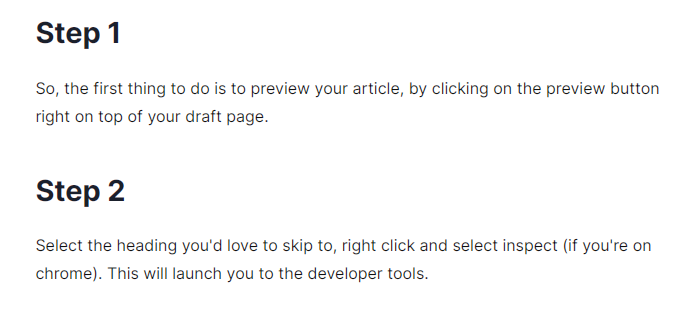
Here's a snippet of same blog, but with visuals:
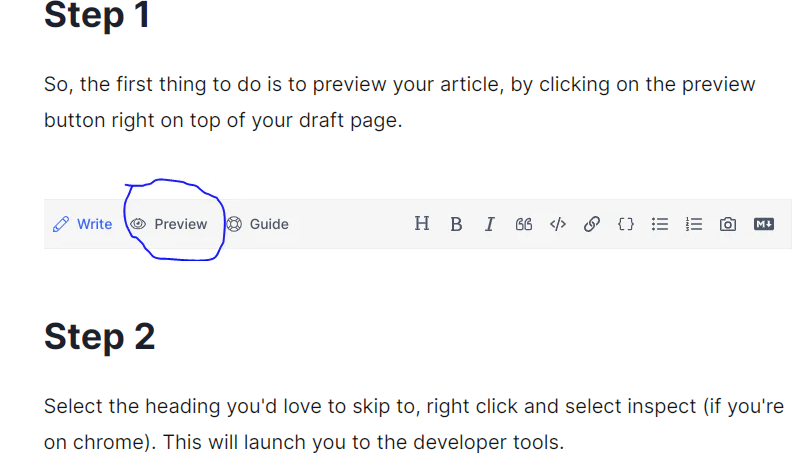
Adding images to your articles makes the content more relatable and easier to understand. In addition to images, you can also use gifs, emoji, embeds (social media, code) and code snippets where necessary.
Thoughtful formatting, templates, and images or diagrams will also make your text more helpful to your readers. You can check out the references below for a technical writing template from @Bolajiayodeji.
Do a Careful Review
Good writing of any type must be free from spelling and grammatical errors. These errors might seem obvious, but it's not always easy to spot them (especially in lengthy documents).
Always double-check your spelling (you know, dot your Is and cross your Ts) before hitting 'publish'.
There are a number of free tools like Grammarly and the Hemingway app that you can use to check for grammar and spelling errors. You can also share a draft of your article with someone to proofread before publishing.
Where to Publish Your Articles
Now that you've decided to take up technical writing, here are some good platforms where you can start putting up technical content for free. They can also help you build an appealing portfolio for future employers to check out.
Dev.to is a community of thousands of techies where both writers and readers get to meaningfully engage and share ideas and resources.

Hashnode is my go-to blogging platform with awesome perks such as custom domain mapping and an interactive community. Setting up a blog on this platform is also easy and fast.
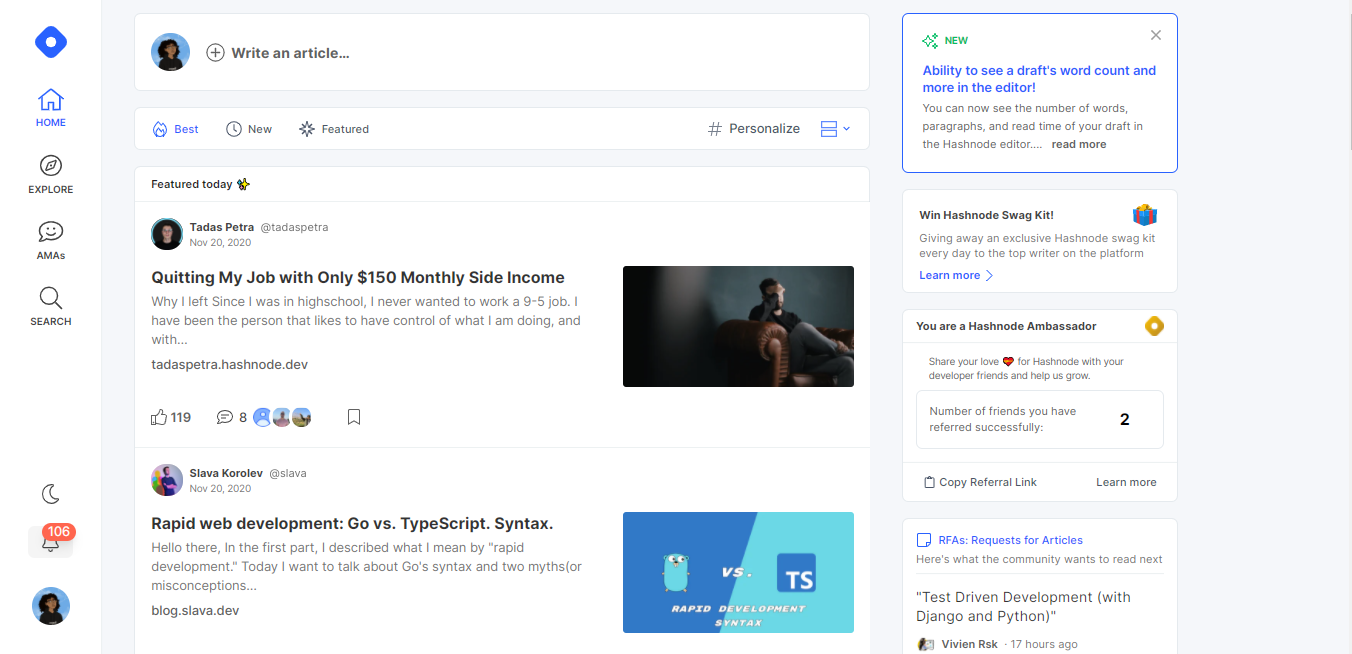
freeCodeCamp has a very large community and audience reach and is a great place to publish your articles. However, you'll need to apply to write for their publication with some previous writing samples.
Your application could either be accepted or rejected, but don't be discouraged. You can always reapply later as you get better, and who knows? You could get accepted.
If you do write for them, they'll review and edit your articles before publishing, to make sure you publish the most polished article possible. They'll also share your articles on their social media platforms to help more people read them.
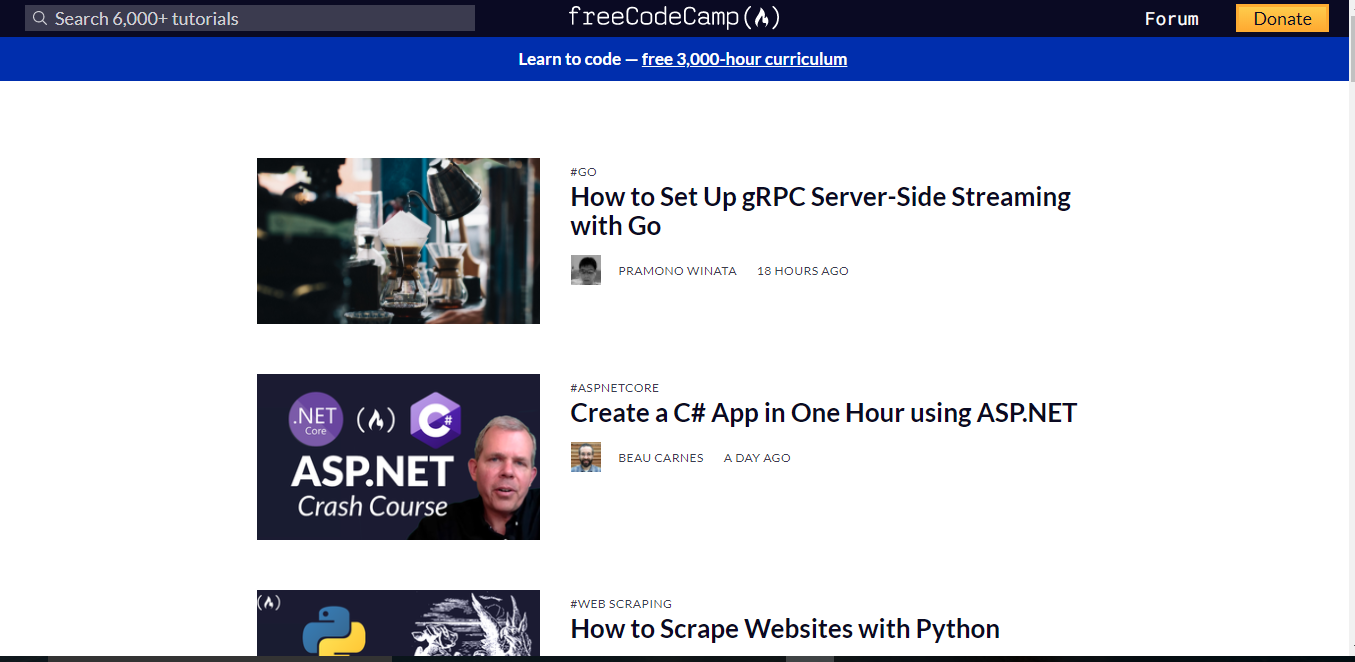
Hackernoon has over 7,000 writers and could be a great platform for you to start publishing your articles to the over 200,000 daily readers in the community.
Hacker Noon supports writers by proofreading their articles before publishing them on the platform, helping them avoid common mistakes.

Just like in every other field, there are various processes, rules, best practices, and so on in Technical Writing.
Taking a course on technical writing will help guide you through every thing you need to learn and can also give you a major confidence boost to kick start your writing journey.
Here are some technical writing courses you can check out:
- Google Technical Writing Course (Free)
- Udemy Technical Writing Course (Paid)
- Hashnode Technical Writing Bootcamp (Free)
Technical Writing Forums and Communities
Alone we can do so little, together, we can do so much ~ Helen Keller
Being part of a community or forum along with people who share same passion as you is beneficial. You can get feedback, corrections, tips and even learn some style tips from other writers in the community.
Here are some communities and forums for you to join:
- Technical Writing World
- Technical Writer Forum
- Write the Docs Forum
Some Amazing Technical Writers to follow
In my technical writing journey, I've come and followed some great technical writers whose writing journey, consistency, and style inspire me.
These are the writers whom I look up to and consider virtual mentors on technical writing. Sometimes, they drop technical writing tips that I find helpful and have learned a lot from.
Here are some of those writers (hyperlinked with their twitter handles):
- Quincy Larson
- Edidiong Asikpo
- Catalin Pit
- Victoria Lo
- Bolaji Ayodeji
- Amruta Ranade
- Chris Bongers
- Colby Fayock
Final words
You do not need a degree in technical writing to start putting out technical content. You can start writing on your personal blog and public GitHub repositories while building your portfolio and gaining practical experience.
Really – Just Start Writing.
Practice by creating new documents for existing programs or projects. There are a number of open source projects on GitHub that you can check out and add to their documentation.
Is there an app that you love to use, but its documentation is poorly written? Write your own and share it online for feedback. You can also quickly set up your blog on hashnode and start writing.
You learn to write by writing, and by reading and thinking about how writers have created their characters and invented their stories. If you are not a reader, don't even think about being a writer. - Jean M. Auel
Technical writers are always learning . By diving into new subject areas and receiving external feedback, a good writer never stops honing their craft.
Of course, good writers are also voracious readers. By reviewing highly-read or highly-used documents, your own writing will definitely improve.
Can't wait to see your technical articles!
Introduction to Technical Writing
How to structure a technical article
Understanding your audience, the why and how
Technical Writing template
I hope this was helpful. If so, follow me on Twitter and let me know!
Amarachi is a front end web developer, technical writer and educator who is interested in building developer communities.
If you read this far, thank the author to show them you care. Say Thanks
Learn to code for free. freeCodeCamp's open source curriculum has helped more than 40,000 people get jobs as developers. Get started

Ultimate Guide to Technical Writing
Published on Apr 29, 2022 in writing by Chris Wolfgang 6 minute read
Ever thought of turning your professional expertise toward writing? Or perhaps you’ve realized that your company needs a skilled writer who understands the ins and outs of your trade. In either case, it’s time to consider technical writing.
What Is Technical Writing?
Technical writing is the concept of writing about the technical knowledge of an industry—think of content like tutorials and documentation. This is writing that educates readers in the technicalities of a certain discipline or task, often aimed at audiences who have at least some area knowledge themselves.
Technical writing is often B2B or B2C content that is tightly focused on education. How does this tool connect with that tool? Which language is better for this use case? Should a software company rehaul its processes to match the trendy new workflow everyone’s talking about or is the ROI not worth it? It’s less about selling the reader on a product and more about educating them in practically achieving a goal.
This article will focus on technical writing for software engineering specifically, but just about every industry has a need for technical writers to clearly explain its hows and whys.
If You’d Like to Try Technical Writing…
If you’ve been in your industry for a while, you may already have some technical writing pieces to your name without even realizing it. Did you help write documentation for a product you built? Did you add to the blog of a startup you worked for a couple years ago? Gather those links and skip to the next section.
For those who need to start at the beginning when it comes to technical writing, you might want to begin with your own blog, either on your own website or a platform like Medium, jot down some ideas for a couple short blog posts. What could you write 1,000 words about that would be helpful for other software engineers to know more about? What troubleshooting did you recently accomplish that had you piecing together tips from five different forums? Get your thoughts organized , don’t forget to proofread your writing, and get it online.
The only way to be a good writer is to write, so focus on consistency and quantity more than perfection, especially if you’re writing for yourself.
And You’d Like to Get Paid For It
Ready to offer your technical writing services for hire? The good news is that these days, most technical writing opportunities are remote . Consider where you like to get your own industry news online; what are the sites you check first when you need answers? Have you run into a blog or a writer that you particularly trust?
Follow the rabbit trail of links that fan out from your usual haunts, and you’ll see where others are writing for your field. If a writing opportunity looks interesting, learn how the company wants writers to apply. They’ll probably ask for links to any published technical writing you may already have. Definitely have a technical writing cover letter ready to go.
First, Understand What You’re Being Asked to Write
Each content agency, news site, online magazine, and company blog will have its own expectations when it comes to technical writing, so be sure you’re comfortable with what they’re asking you to provide. After all, there’s a difference between writing a tutorial , comparing two or three tools , and composing a roundup of the top twenty JavaScript plug-ins of the year.
Then Be Prepared for Style Guides and Edits
Online publishing is only getting more sophisticated as individual businesses become more comfortable producing their own content. Don’t be surprised if you’re asked to adhere to a style guide or if your work goes through some edits.
Most companies with an established marketing department will have their own style guide, but you can get an idea of what you might be asked for in any of these style examples, including from Draft.dev .
The more closely your work sticks to the required style, the less rigorous the edits will be on your writing. Still, you should expect at least one round of edits from whoever you’re writing for. Draft.dev has between three and five rounds of edits per article, encompassing a technical review, a development edit, and a copy edit.
If You Need a Technical Writer…
Technical writing is no joke. It takes attention to detail, a willingness to research, a skilled hand at writing, and the ability to take an edit professionally. Many companies see the need for technical writing but either aren’t large enough to staff their own content creation or would prefer to focus on their core skills and leave the writing to someone else entirely.
And You’d Like to Find a Good One
If your business is looking to establish an ongoing relationship with a freelance technical writer, we’re happy to share our hiring tricks at Draft.dev . Finding the perfect writer for you is a multi-step process—from knowing exactly what you’re looking for to knowing where to look and how to reach out to them—but in the end, you’ll be happy you put in the time and care in your search.
First, Consider What You Need From the Writer
Ideally, you’re looking for someone already experienced in technical writing. They’ve either written consistently on their own bit of internet real estate, or they have at least a few bylines with voices of authority in the industry. Other than that, what you’re looking for in a writer is not necessarily the same as what your competitor might want. Your marketing goals, your client demographic, and the messages you want to convey all make for your own unique wish list.
However, there are some red flags that will probably always warrant a polite no, thank you email from your hiring manager.
Someone who’s written across a wide variety of unrelated industries is probably an experienced content marketer who’s great at research. Chances are you need someone with deeper knowledge. Software engineering in particular doesn’t lend itself to turning quick research into authoritative writing. Other flags to be watchful for include a generally unprofessional attitude (you need this person to be self-motivated and reliable), a lack of familiarity with common online collaboration tools (Google Suite, GitHub), and field experience but too little of it (you don’t want to hand an advanced Kubernetes assignment to someone who finished a code boot camp last week).
Then, Consider What You Need For Your Team
As already mentioned, finding the correct technical writer for your goals takes time. Editing their work and getting it ready for publication on your platform are other time sinks. If your team is better suited to focusing on your core business rather than creating content resources for your audience, consider working with a technical writing service instead.
These services come in a variety of shapes and sizes , so again, take time to get clear about what your own business needs from one of them. Are you looking for a full-service marketing agency, or do you want them to prioritize industry knowledge while you handle the content publication and promotion? Do you want to be one of a few clients for a boutique content agency, or are you looking for something less infinitely customizable and more of a low-code/no-code solution?
Explore the Technical Writing You Need
If you’re a developer interested in getting into technical writing, it might be time for you to apply to write at Draft.dev . If your software company needs to step up its content creation, schedule a call to see if Draft.dev is a good fit for your vision .
Want to learn more before getting in touch with us? Take a stroll through the Writing tags in Draft.dev’s blog. You’ll find a variety of information ready to help you determine where you’d like to go next with technical writing.

By Chris Wolfgang
Chris Wolfgang is the editor at Draft.dev. She’s been writing and editing for tech for longer than she would care to remember.

Build a Blog that Software Developers Will Read
The Technical Content Manager’s Playbook is a collection of resources you can use to manage a high-quality, technical blog:
- A template for creating content briefs
- An Airtable publishing calendar
- A technical blogging style guide

IMAGES
VIDEO
COMMENTS
Here are 13 examples of SMART goals for technical writers: 1. Improve Writing Speed. “To increase my efficiency and productivity, I’ll double my average words per minute by the end of 7 months. I’ll achieve this using tech-based tools, such as automated copyediting software, to help me write faster and more accurately.”.
Usually, we set vague, unspecified, open-ended goals but setting the right goals is essential for technical writers since it’ll help to write clear and user-friendly content step by step. In this…
Setting Career Goals as an Entry-Level Technical Writer At the entry-level, your primary aim is to establish a strong foundation in technical communication. Goals should focus on developing a keen understanding of technical subjects, honing your writing skills, and becoming proficient with industry-standard tools and documentation software.
The goal of both business and technical writing is to be easily understood. Technical writing, however, is solely concerned with conveying information, whereas business writing can vary in style and tone. Business writing, for example, can be persuasive, such as when attempting to sway someone toward your point of view.
A technical writer is responsible for a number of tasks, including: Gathering technical information on their company's or department's line of business. Plan the creation of technical documents according to the needs of the company. Sort information according to its relevance and value. Create and edit the necessary documentation.
Technical Writing Process: Step-by-step Guide. In this article, we’re bringing you a technical writing process that will help you create valuable, focused, and well-researched documentation for every feature of your product. The process of writing technical documentation is by no means an easy one. In addition to having excellent writing ...
Technical writing can take many forms, including user manuals, how-to guides, technical reports, white papers, and more. The goal is always the same: to make complex information understandable and usable. Importance of Technical Writing in Today’s Digital Age. In our increasingly digital world, technical writing has become more important than ...
Technical writing is the art of providing detail-oriented instruction to help users understand a specific skill or product. And a technical writer is someone who writes these instructions, otherwise known as technical documentation or tutorials. This could include user manuals, online support articles, or internal docs for coders/API developers ...
Technical writing is the concept of writing about the technical knowledge of an industry—think of content like tutorials and documentation. This is writing that educates readers in the technicalities of a certain discipline or task, often aimed at audiences who have at least some area knowledge themselves. Technical writing is often B2B or ...
Technical writing is writing about a particular subject requiring direction, instruction, explanation or clarification. It is a method of communication used by experts and professionals to convey…